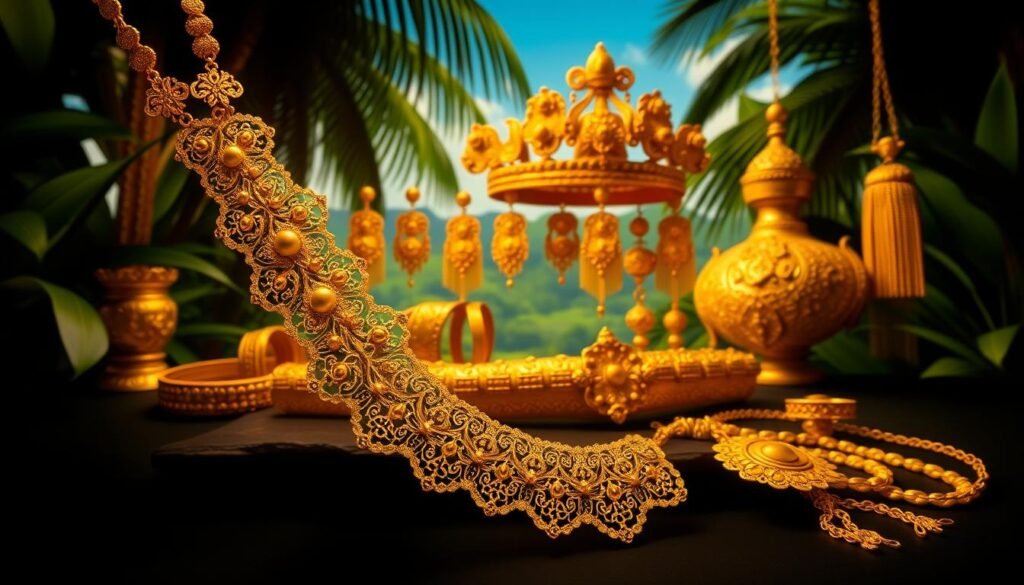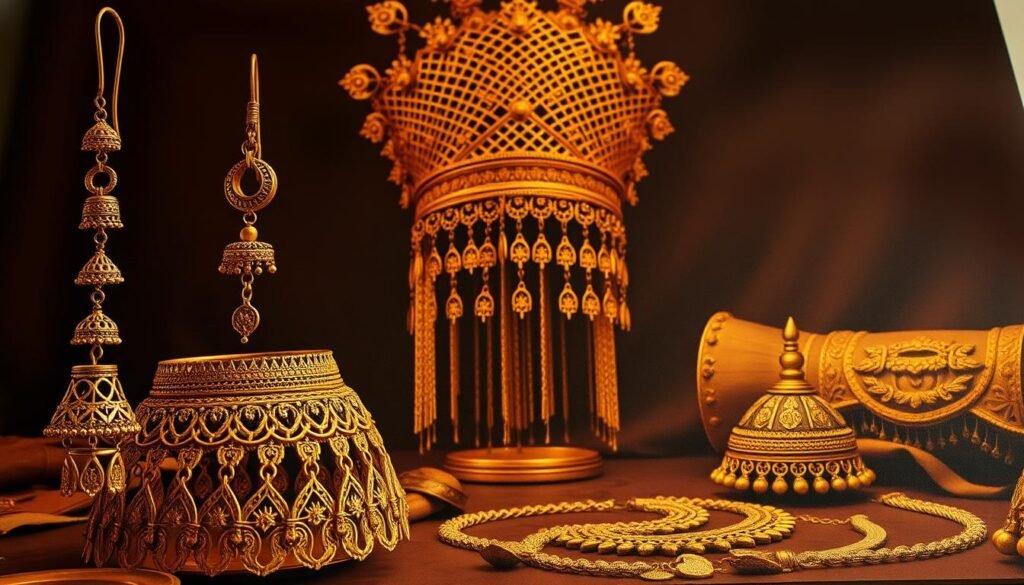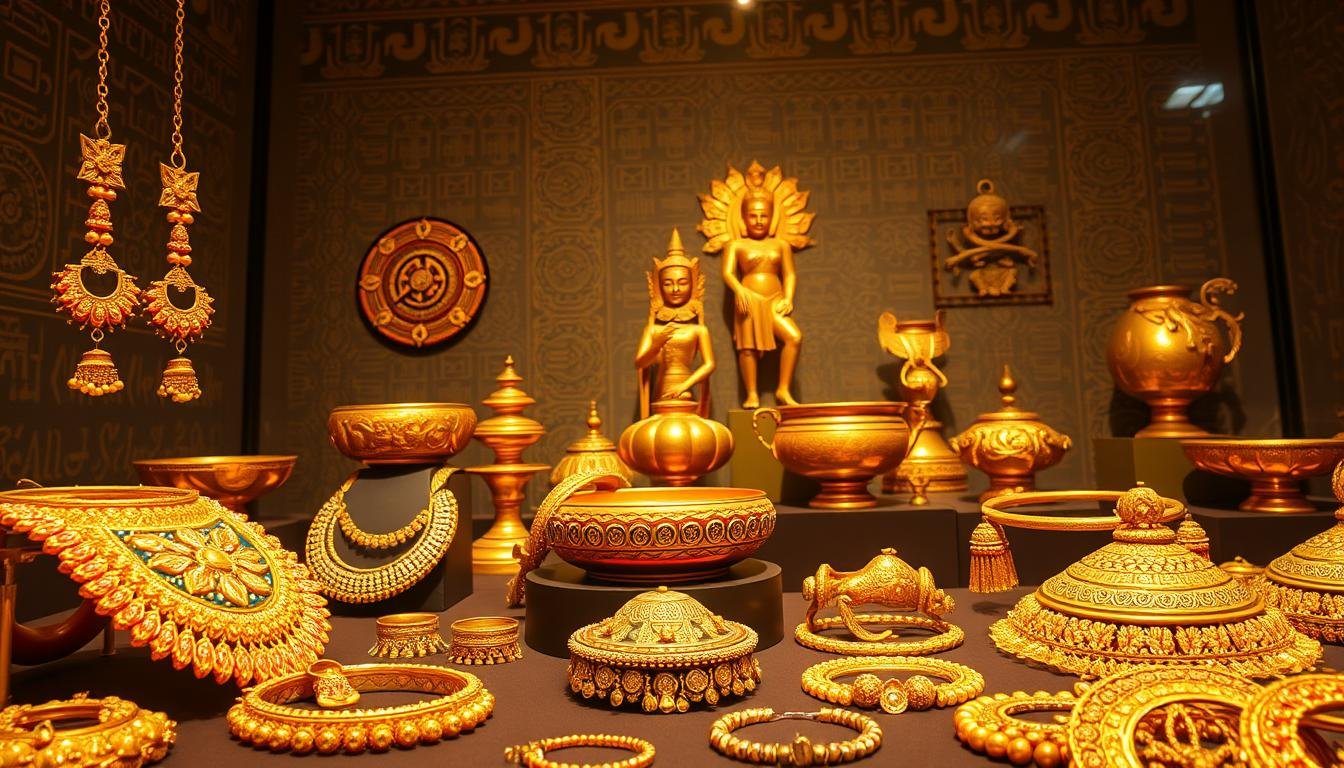Did you know that ancient Filipino gold artifacts date back over 1,200 years? These treasures, discovered in places like Surigao, reveal a rich history of craftsmanship and cultural significance. Gold was more than just a metal; it symbolized wealth, power, and spirituality in precolonial Filipino society.
From intricate jewelry to ceremonial weapons, these artifacts showcase the advanced skills of Filipino goldsmiths. Techniques like granulation and lost-wax casting were used to create stunning pieces that still captivate the world today. The allure of gold remains strong, connecting our past to the present year.
This article explores the treasures of our ancestors, their craftsmanship, and how gold continues to influence both culture and economy. Join us as we uncover the stories behind these timeless artifacts.
Key Takeaways
- Ancient Filipino gold artifacts date back over 1,200 years.
- Gold symbolized wealth, power, and spirituality in precolonial society.
- Advanced techniques like granulation were used in crafting these treasures.
- These artifacts connect the past to the present year.
- Gold continues to influence both culture and economy in the Philippines.
Introduction to Ancient Filipino Gold
The ancient treasures of the Philippines reveal a story of cultural depth and ancestral pride. These artifacts, crafted with precision and care, were more than just adornments. They symbolized divinity, power, and the spiritual connection of precolonial communities.

Cultural Significance and Ancestral Roots
Gold held a sacred place in ancient Filipino society. It was used in rituals, ceremonies, and as a marker of social status. The intricate designs of these artifacts reflect the advanced skills of early Filipino artisans.
Oral traditions and historical accounts highlight how gold was deeply intertwined with the identity of early communities. From necklaces to ceremonial weapons, each piece tells a story of heritage and craftsmanship.
Historic Value and Timeless Appeal
The historic value of these artifacts is undeniable. They serve as a bridge between past civilizations and the present year, offering insights into ancient trade practices and cultural exchanges.
Influences from neighboring regions and global interactions are evident in the designs and techniques used. These treasures continue to captivate the world, showcasing the Philippines’ rich history.
Understanding the fluctuations in gold price throughout history also sheds light on its economic significance. From ancient trade to modern markets, gold has remained a symbol of wealth and stability.
- Gold artifacts symbolized divinity and power in ancient communities.
- Oral traditions and craftsmanship highlight cultural significance.
- Historic value connects past civilizations with the present.
- Global influences shaped ancient mining and trade practices.
- Gold price fluctuations reflect its enduring economic impact.
Historical Journey of Filipino Gold
Centuries ago, the Philippines was a hub of gold craftsmanship and trade. Early discoveries in the archipelago revealed a wealth of raw materials that shaped its history. These findings, often tied to legendary tales, highlight the region’s significance in the ancient world.

Ancient artisans used advanced techniques to transform raw gold into intricate artifacts. Methods like granulation and lost-wax casting showcased their skill and creativity. These pieces were not just decorative but also held deep cultural and spiritual meaning.
Trade routes played a crucial role in spreading Filipino gold across the world. Interactions with neighboring cultures enriched the designs and techniques used. This exchange of ideas and materials cemented the Philippines’ place in global history.
From mining to crafting, the journey of gold reflects the ingenuity of early communities. Today, these artifacts serve as a testament to their legacy, connecting the past to the present year.
Early Discoveries and Ancient Craftsmanship
Archaeological finds in regions like Surigao and Cebu reveal the extent of early gold mining. These discoveries include tools, jewelry, and ceremonial items. Each piece tells a story of the people who created and used them.
The craftsmanship of these artifacts is unmatched. Artisans combined technical skill with artistic vision to produce stunning works. Their techniques, passed down through generations, continue to inspire modern practices.
Gold’s availability in nature made it a prized material. Its durability and luster ensured its use in significant cultural events. From harvest celebrations to warfare victories, gold was a symbol of prosperity and power.
These ancient treasures remind us of the Philippines’ rich heritage. They bridge the gap between past and present, offering insights into a world shaped by gold.
Gold: A Timeless Symbol in Filipino Culture
In the heart of Filipino culture, gold has always been more than just a precious metal. It represents spirituality, power, and the enduring legacy of ancestral traditions. From rituals to heirlooms, its presence has shaped the identity of the Filipino people for centuries.

Symbolism and Ritual Uses
Gold played a sacred role in ancient Filipino rituals and ceremonies. It was often used in offerings to deities, symbolizing purity and divine favor. In many communities, gold artifacts were believed to carry spiritual energy, connecting the physical and spiritual worlds.
Myths and legends further highlight its importance. Stories of gods and heroes often feature gold as a symbol of power and immortality. These narratives have been passed down through generations, preserving the cultural significance of this precious metal.
Artifacts that Tell a Story
Notable artifacts, such as the Surigao Treasure, showcase the artistic and spiritual connection ancient Filipinos had with gold. These pieces, including intricate jewelry and ceremonial items, reflect the advanced craftsmanship of early artisans.
Each artifact tells a unique story. For example, the gold kinnari, a mythical bird-woman figure, symbolizes grace and prosperity. Such pieces continue to inspire awe and respect, both locally and globally.
| Artifact | Significance |
|---|---|
| Surigao Treasure | Represents wealth and spiritual power in ancient Filipino society. |
| Gold Kinnari | Symbolizes grace, prosperity, and mythical beauty. |
| Ceremonial Weapons | Used in rituals to signify strength and protection. |
The legacy of these artifacts extends beyond their historical value. They influence modern perceptions of gold, driving its demand in the global market. Today, gold remains a symbol of stability and cultural pride, bridging the past and the present year.
The Artistry and Craftsmanship of Ancient Gold
The artistry of ancient Filipino metalwork continues to inspire awe and admiration. From delicate filigree to intricate embossing, these techniques showcase the skill and creativity of early artisans. Each piece tells a story of cultural pride and innovation.

Traditional Techniques Passed Through Generations
Filipino artisans mastered techniques like granulation and cloisonné, creating stunning works of art. Granulation involved arranging tiny metal spheres into patterns, while cloisonné used hammered strips to form designs. These methods required precision and patience.
Filigree, a delicate form of metalwork, was also widely used. Artisans twisted fine wires into intricate patterns, often seen in jewelry and ceremonial items. These techniques were passed down through generations, preserving a rich cultural heritage.
Preservation and Restoration Practices
Preserving ancient artifacts is crucial for maintaining cultural history. Modern restoration science combines traditional methods with advanced technology. This ensures that delicate pieces are protected for future generations.
Conservation efforts focus on stabilizing materials and preventing deterioration. Experts use techniques like laser cleaning and chemical treatments to restore artifacts without damaging them. These practices bridge the gap between ancient craftsmanship and modern science.
“The preservation of these artifacts is not just about maintaining their physical form but also honoring the stories they tell.”
Today, these ancient techniques influence contemporary art and design. They remind us of the Philippines’ rich artistic legacy and its impact on the world. By preserving these practices, we ensure that the artistry of our ancestors continues to inspire.
Market Insights: Gold Price Trends and Analysis
The global market for precious metals has seen significant shifts in recent years, with gold leading the charge. Understanding the dynamics behind these changes is crucial for investors and analysts alike. This section delves into the factors driving gold price fluctuations, local and global market trends, and the sources of these movements.

Understanding Gold Price Dynamics
Gold prices are influenced by a variety of factors, including economic events, market sentiment, and supply and demand shocks. For instance, in January 2024, prices surged due to increased demand for safe-haven assets amid rising geopolitical tensions. Investor behavior also plays a significant role, as seen in the record highs achieved during the year.
Technical analysis is essential for predicting future trends. Tools like moving averages and support/resistance levels help analysts understand market behavior. The XAU/USD pair has shown a bullish trend, indicating potential for further growth.
Local and Global Market Trends
Local markets in the Philippines have seen steady demand for gold, driven by cultural significance and economic stability. Globally, central banks have been major buyers, with purchases exceeding 1,000 tonnes in 2024. This has significantly impacted the gold price, pushing it to new highs.
In Europe, prices increased by 4% in the second half of 2023, reflecting strong demand. Similarly, in Asia, retail demand has been robust, supporting higher prices. These trends highlight the interconnectedness of local and global markets.
Source and Analysis of Price Fluctuations
Price fluctuations are often tied to economic indicators and geopolitical events. For example, the Federal Reserve’s interest rate decisions have a direct impact on gold prices. In 2024, expectations of rate cuts led to increased investment in gold, driving prices up.
Supply chain disruptions and mining output also play a role. In 2024, mine production increased slightly, but recycled gold supply rose by 11%, adding to the overall supply. These factors, combined with investor sentiment, create a complex landscape for price analysis.
| Period | Average Gold Price (USD/oz) |
|---|---|
| Q4 2023 | 2,042 |
| Q1 2024 | 2,386 |
| Q2 2024 | 2,663 |
Understanding these dynamics helps investors make informed decisions. By analyzing trends and economic indicators, one can better navigate the volatile world of gold trading.
Mining and Sourcing: From Ancient Methods to Modern Techniques
The journey of gold mining in the Philippines spans centuries, evolving from simple techniques to advanced methods. This transformation reflects the ingenuity and adaptability of Filipino miners, who have continuously improved their practices to meet the demands of their time.

Ancient Mining Practices in the Philippines
In ancient times, mining was a labor-intensive process that relied on basic tools and natural resources. Early Filipinos used wooden shovels, baskets, and river pans to extract gold from riverbeds and shallow deposits. These methods, though rudimentary, were effective in yielding small but significant amounts of the precious metal.
Fire-setting was another technique employed to break rocks and access deeper deposits. This method involved heating rocks with fire and then cooling them rapidly with water, causing them to crack. Such practices highlight the resourcefulness of ancient miners, who worked with limited technology but achieved remarkable results.
Modern Extraction and Refinement Processes
Today, mining in the Philippines has embraced advanced technologies to enhance efficiency and sustainability. Modern methods include open-pit mining, cyanide leaching, and the use of heavy machinery. These techniques allow for the extraction of larger quantities of gold while minimizing environmental impact.
Refinement processes have also improved, with innovations like carbon-in-pulp and electrowinning ensuring higher purity levels. These advancements have positioned the Philippines as a key player in the global gold market, contributing significantly to the economy each year.
The evolution of mining practices underscores the importance of balancing tradition with innovation. As the industry continues to grow, it remains committed to preserving the rich heritage of Filipino mining while embracing the opportunities of the modern world.
For more insights into the history of mining, visit this resource.
Global Influence: The Impact of Filipino Gold on World Markets
The Philippines has long been a key player in the global gold market, shaping economies and cultures far beyond its borders. From ancient trade routes to modern financial systems, Filipino gold has been a driving force in global commerce. Its influence is evident in both historical artifacts and ongoing mining efforts.

Historical artifacts, such as the Surigao Treasure, highlight the Philippines’ early contributions to the global supply of gold. These pieces not only showcase the craftsmanship of ancient artisans but also underscore the country’s role in international trade. Today, mining continues to play a vital role in the global market, with the Philippines being a significant source of this precious metal.
Regional Demand and Economic Drivers
Regional demand for gold is influenced by a variety of economic factors. In Asia, cultural significance and economic stability drive steady consumption. The Philippines, in particular, sees consistent demand due to its rich heritage and the metal’s role in traditional practices.
Globally, central banks have been major buyers, with purchases exceeding 1,000 tonnes in 2024. This has significantly impacted the gold price, pushing it to new highs. Economic indicators, such as interest rate decisions and geopolitical events, also play a crucial role in shaping demand.
For example, in January 2024, prices surged due to increased demand for safe-haven assets amid rising tensions. This highlights the interconnectedness of local and global markets. The ripple effect of local mining outputs on the world market cannot be overstated.
| Region | Gold Demand (2024) |
|---|---|
| Asia | 1,200 tonnes |
| Europe | 800 tonnes |
| North America | 600 tonnes |
The historical context of Filipino gold mining, as explored in this study, reveals its deep-rooted impact on global trade. From the Manila-Acapulco galleon trade to modern-day exports, the Philippines has consistently contributed to the global supply of gold.
Understanding these dynamics helps investors and analysts navigate the volatile world of gold trading. By analyzing trends and economic indicators, one can better appreciate the enduring influence of Filipino gold on the world stage.
Conclusion
From ancient rituals to modern markets, the story of Filipino gold is a testament to its enduring legacy. This precious metal has shaped the cultural and economic landscape of the Philippines for centuries. Its journey from intricate craftsmanship to global trade highlights the resilience and innovation of Filipino artisans.
The cultural significance of gold remains deeply rooted in Filipino heritage. It symbolizes wealth, power, and spirituality, connecting generations through its timeless appeal. Historical artifacts, like the Surigao Treasure, continue to inspire awe and pride.
Modern market dynamics reveal the ongoing influence of gold on the global stage. Price fluctuations, driven by economic indicators and geopolitical events, underscore its role as a safe-haven asset. Reliable source data and detailed analysis are essential for understanding these trends.
As we look ahead, the evolution of mining and refinement practices ensures that gold remains a vital part of the world economy. Its story is a bridge between the past and the future, reminding us of the Philippines’ rich history and its impact on the world.
FAQ
What is the cultural significance of ancient Filipino gold?
Ancient Filipino gold holds deep cultural importance, symbolizing wealth, power, and spirituality. It reflects the rich heritage and ancestral roots of Filipino communities.
How did early Filipinos craft gold artifacts?
Early Filipinos used traditional techniques like hammering, casting, and engraving to create intricate gold artifacts. These methods were passed down through generations.
What role did gold play in Filipino rituals?
Gold was often used in rituals and ceremonies, representing divine connections and social status. It was also buried with the dead as a sign of respect and honor.
How are ancient gold artifacts preserved today?
Preservation involves careful restoration and modern conservation techniques. Museums and cultural institutions play a key role in safeguarding these treasures.
What factors influence gold price trends?
Gold prices are affected by global demand, economic conditions, and market speculation. Local mining output and geopolitical events also play a role.
How has gold mining evolved in the Philippines?
Mining has shifted from ancient manual methods to modern techniques. Today, advanced technology is used for extraction and refinement, improving efficiency and safety.
What impact does Filipino gold have on global markets?
Filipino gold contributes to regional demand and influences global trade. Its unique craftsmanship and historical value make it a sought-after commodity worldwide.
Source Links
- Philippine Art, Culture and Antiquities
- What Does Gold Tell Us About Philippine History?
- Philippines’ forgotten gold rediscovered
- Exploring the Rich Heritage of Filipino Jewelry: A Testament to Culture and Craftsmanship – Mustaqim
- A Brief History Of Philippine Gold Jewelry
- Yamashita’s gold
- GOLD AND WOOD: MATERIAL CULTURE AND RITUAL IN PRECOLONIAL AND CATHOLIC PHILIPPINES
- Philippine Gold: Southeast Asian Trade and Transmission — Orientations
- 8 Chic Jewelry Pieces That Celebrate Filipino Heritage and Identity
- Gold in Ancient Egypt – The Metropolitan Museum of Art
- The Radiant History of Gold in Art – Jackson’s Art Blog
- Gold Demand Trends: Full Year 2024
- A new high? | Gold price predictions from J.P. Morgan Research
- Gold Price Trend and Forecast
- Ancient Mining: Methods & Techniques
- Gold Mining: From Ancient Times to Modern Innovations and Challenges
- Philippines (09/05)
- Colonial Contractions: The Making of the Modern Philippines, 1565–1946 – Oxford Research Encyclopedia of Asian History

